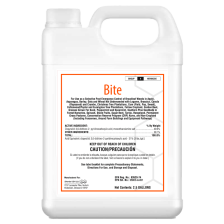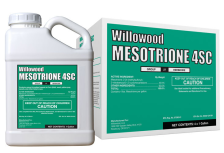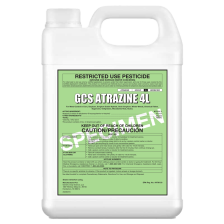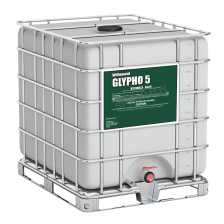Clopyralid 101: Everything Farmers Need to Know About Clopyralid
This guide includes the following sections:
What Is Clopyralid?
Clopyralid is a selective, systemic, post-emergence herbicide commonly used to control broadleaf weeds in labeled row and specialty crops. Most clopyralid applied in U.S. agricultural settings is used in corn and wheat crops. It is one of the few herbicides that can effectively terminate cover crops in corn and wheat, with limited risk for crop injury.
It can also help manage weeds on fallow acres, pastures, and rangeland. Other uses include roadside and right-of-way management.
Clopyralid was first registered for use in the United States in 1987. Products that contain clopyralid as an active ingredient include the herbicides Stinger®, Bite*, Spur®*, and Transline®.
How Does Clopyralid Work?
Clopyralid is a Group 4 synthetic auxin site-of-action herbicide in the pyridine carboxylate chemical family, which also includes aminopyralid. It has a growth regulator mode of action and works by stimulating rapid growth in the growing points of broadleaf weeds, destroying vascular tissue, and ultimately causing plant death.
Other growth regulator mode of action herbicides include dicamba, 2,4-D, and MCPA.
How Long Does Clopyralid Take to Work?
Clopyralid is a systemic herbicide absorbed through the weed’s leaves and roots and translocated throughout the plant. The herbicide must contact foliage to be effective. However, since the active ingredient is translocated within the plant, complete foliage coverage is less critical than contact herbicides without systemic activity.
Depending on weed pressure, target weeds, and environmental conditions, complete weed kill timing could vary from days to weeks. Typically, systemic herbicides work more effectively when growing conditions are more favorable for plant growth and when plants are not under stress.
Visual symptoms include petiole curling and strapped, elongated, or malformed new foliage.
Clopyralid Application Rates
Clopyralid is a post-emergent herbicide that has activity on emerged weeds. It is especially effective against annual and perennial broadleaf weeds, including knapweeds, thistles, dandelions, and clover.
Below are typical use rates for Bite* herbicide in various cropping systems. Consult the product label for specific application timing recommendations and suitable tank mix partners.
Clopyralid application rates will vary depending on the following:
Product applied
Application timing
Soil characteristics and organic content
Crop
Targeted weed species
Weed pressure
Clopyralid has a long half-life in soil, making herbicide carryover in subsequent crops a concern. To avoid crop injury, follow crop rotational intervals as directed on the clopyralid product label.
Ready to optimize your post-emergence herbicide strategy? Find herbicides that might be a good fit for your acres.
How to Tank Mix with Clopyralid
Clopyralid can be tank-mixed with other herbicide active ingredients for broad-spectrum weed control, including management of grass species on which it has limited activity. You can also find clopyralid in a number of premix pre-emergence herbicides, including Resicore®* .
The pesticide applicator is accountable for ensuring all products are registered for the intended use. Follow the relevant directions, restrictions, and limitations for usage on all product labels involved in tank mixing. Below are some common clopyralid tank-mix partners in various cropping systems.
Corn
Clopyralid can be combined with many common corn herbicides, including acetochlor, flumetsulam, mesotrione, and atrazine*.
Wheat
Clopyralid tank mixed with fluroxypyr provides effective kochia control.
Sugar Beets
A tank mix of clopyralid, glyphosate, S-metolachlor, and ethofumesate* herbicides is effective against a broad spectrum of weeds in glyphosate-tolerant sugar beets.
Rangeland Management
Aminopyralid and picloram* are effective clopyralid tank mix partners for managing rangeland weeds.
Non-Cropland (Fencerows, Etc.)
To better control mature weeds, consider adding 2,4-D amine* or low-volatile ester to a clopyralid tank mix.
Wondering if a premix or custom tank mix is the best option? Check out this blog for tips.
Clopyralid Resistance Management
While only a few weed species have documented resistance to clopyralid, growers must take steps to steward the chemistry and avoid overuse when possible. As with any herbicide, repeated applications can add selection pressure for weed populations with natural clopyralid tolerance.
7 Tips to Slow the Development of Clopyralid-Resistant Weed Populations
Make timely herbicide applications according to label guidelines
Use multiple herbicides and multiple modes of action
Employ crop rotation to diversify herbicides
Use full herbicide rates and layered residuals to extend the window of weed control
Add effective labeled adjuvants to improve spray performance and plant uptake
Scout fields after applications to verify weed kill
Add cultural or mechanical weed control practices, including tillage where appropriate
Learn how to manage 5,000 pests through the FBN Pest Solutions pages.
Clopyralid Human and Environmental Safety Guidelines
Clopyralid Human Safety Guidelines
Ensure the safe use of clopyralid by following all label instructions, including these safety guidelines:
Do not enter treated areas during the restricted entry interval (REI), which is 12 hours for most registered clopyralid products.
When handling clopyralid, wear appropriate personal protective equipment (PPE), including a long-sleeved shirt, pants, chemical-resistant gloves, closed-toe shoes, socks, and protective eyewear.
Wash your hands after handling the herbicide and remove clothing and PPE immediately if the product gets on them.
Follow all label instructions to ensure the safe use of clopyralid.
Clopyralid Environmental Safety Guidelines
Clopyralid may risk leaching under certain conditions, resulting in groundwater contamination. Additionally, many terrestrial plants are sensitive to clopyralid. It’s important to follow all labeled guidelines regarding application near sensitive ecological areas.
Environmental safety guidelines for clopyralid include:
Avoid applying to highly permeable soils (sand/loamy sand) where the water table is shallow.
Avoid applications when rainfall or irrigation is expected to occur within 48 hours to reduce leaching potential.
Protect non-target plants by following label directions intended to minimize spray drift.
Be mindful of residual herbicide that may contaminate waste water from equipment and/or tank cleaning.
Buy Clopyralid at FBN
Clopyralid is an effective, flexible-use, post-emergence herbicide that can be useful in terminating cover crops in corn and wheat crops, controlling emerged weeds in row and specialty crops, or managing rangeland and pasture areas.
FBN offers single-active-ingredient clopyralid formulations, such as Bite* and Alligare® Clopyralid 3, for custom tank-mixing. If you prefer a premix that delivers handling ease and broad-spectrum weed control, consider a herbicide like Resicore®*, Aceto (2.80) + Meso (0.30) + Clopy (0.19) Value Pick, or Aceto (3.75) + Clopyralid + Flumet (0.12) Value Pick.
With a convenient online platform, transparent pricing, and direct-to-farm delivery available on your schedule, FBN puts Farmers First®.
Related Resources
Herbicides 101: Everything Growers Need to Know About Herbicides
Clethodim 101: Everything Growers Need to Know About Clethodim
Glufosinate 101: Everything Farmers Need to Know About Glufosinate
Glyphosate 101: Everything Farmers Need to Know About Glyphosate
Fungicides 101: Everything Farmers Need to Know About Fungicides
Insecticides 101: Everything Farmers Need to Know About Insecticides
Inoculants 101: Everything Farmers Need to Know About Inoculants
Biostimulants 101: Everything Growers Need to Know About Biostimulants
Copyright © 2014 - 2024 Farmer's Business Network, Inc. All rights Reserved. The sprout logo, “Farmers Business Network”, "Farmers First", “FBN”, “FBN Direct,” and “FieldGrip” are servicemarks, trademarks or registered trademarks of Farmer's Business Network, Inc.
The following Trademarks are the property of their Owners as listed, or their affiliates. Albaugh LLC: Spur; Alligare, LLC: Alligare, Triumph; Corteva: Resicore, Stinger, Transline.
All other trademarks are the property of their respective owners. Bite is a restricted-use pesticide.
Spur is a restricted-use pesticide.
Resicore® is a restricted-use pesticide.
GCS Atrazine 4L is a restricted-use pesticide.
Willowood Ethofumesate 4SC is a restricted-use pesticide.
Alligare Triumph 22K is a restricted-use pesticide.
Alligare® 2,4-D Amine is a restricted-use pesticide.
*Restricted Use Pesticides due to acute toxicity. For retail sale to and use by certified applicators only – NOT to be used by uncertified persons working under the supervision of a certified applicator.
FBN Direct products and services and other products distributed by FBN Direct are offered by FBN Inputs, LLC and are available only in states where FBN Inputs, LLC is licensed and where those products are registered for sale or use, if applicable. If applicable, please check with your local extension service to ensure registration status. Nothing contained on this page, including the prices listed should be construed as an offer for sale, or a sale of products. All products and prices are subject to change at any time and without notice. Terms and conditions apply.
ALWAYS READ AND FOLLOW LABEL DIRECTIONS. It is a violation of federal and state law to use any pesticide product other than in accordance with its label. The distribution, sale and use of an unregistered pesticide is a violation of federal and/or state law and is strictly prohibited. We do not guarantee the accuracy of any information provided on this page or which is provided by us in any form. It is your responsibility to confirm prior to purchase and use that a product is labeled for your specific purposes, including, but not limited to, your target crop or pest and its compatibility with other products in a tank mix and that the usage of a product is otherwise consistent with federal, state and local laws. We reserve the right to restrict sales on a geographic basis in our sole discretion. You must have a valid applicator license to use restricted use pesticides. Please consult your state department of agriculture for complete rules and regulations on the use of restricted use pesticides, as some products require specific record-keeping requirements.
The material provided is for educational purposes only. It is not intended to be a substitute for specific agronomic, business, legal, investment or professional advice. Where specific advice is necessary or appropriate, consult with a qualified agronomist, financial planner, or investment manager. Neither Farmer's Business Network, Inc. nor any of its affiliates makes any representations or warranties, express or implied, as to the accuracy or completeness of the statements or any information contained in the material and any liability therefore is expressly disclaimed.






